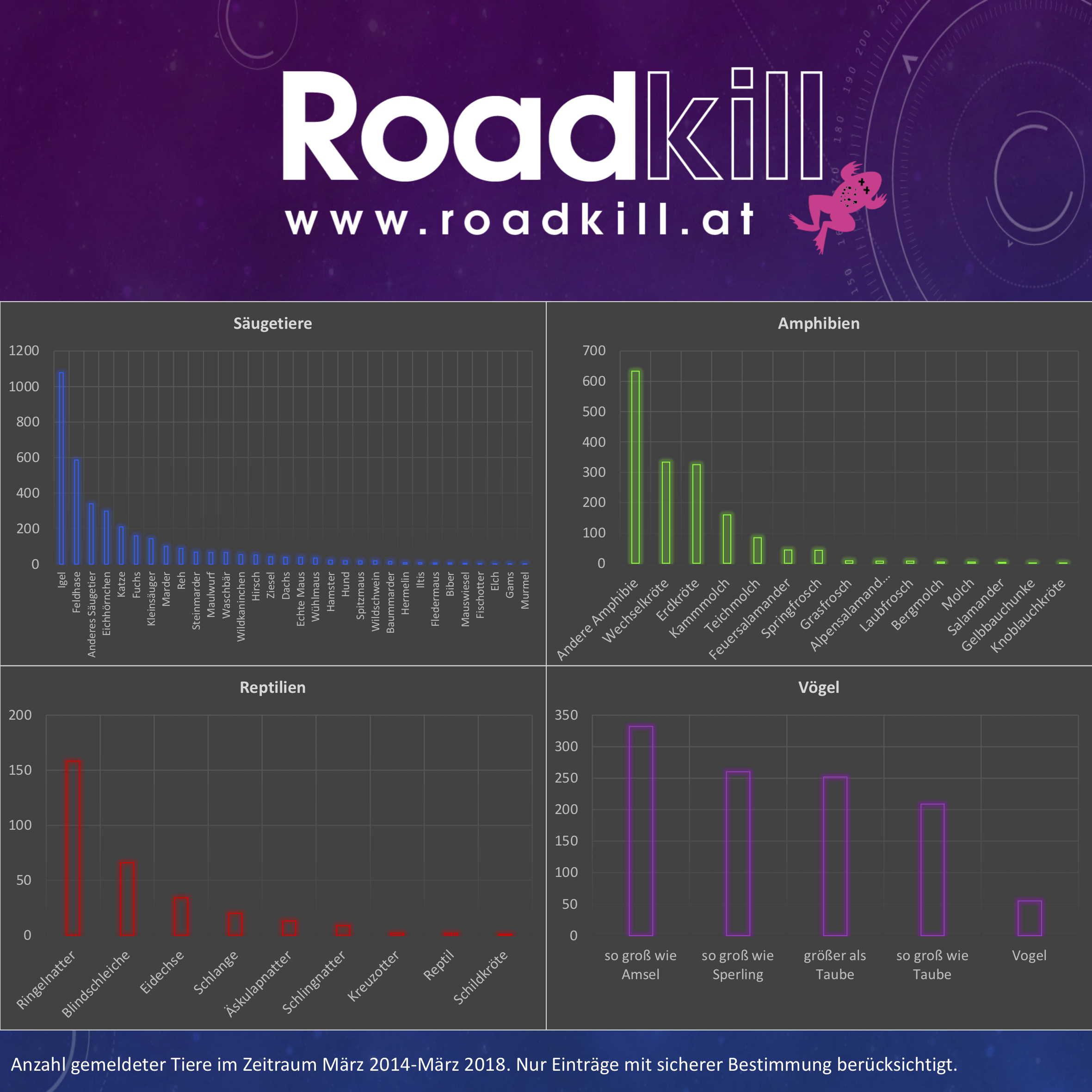News
Up-to-date news are shown on this page.
Spring is approaching on the road
Even if the nights are still cold and there is still snow in the mountain regions, one notices how the temperatures slowly rise and the life in nature awakes again. The leaf buds on bushes and trees become thicker and thicker and prepare for sprouting. These are the first signs of early spring, which we use to prepare for the coming season. As the temperatures rise, the vertebrates wake up from their hibernation and become active again.
For example, squirrels are often seen chasing each other to prepare for mating. During these playful hunts the animals unfortunately frequently overlook moving cars on the streets. So please pay more attention to the animals on the roads again - also in residential areas with speed limits below 30km/h.
The nature protection associations, like our partners the Naturschutzbund in Lower Austria or the ARGE Naturschutz, are already in the middle of the preparations to install amphibian fences on roads. You can find more information about amphibian migration, which is only a few weeks away, here (in German). The Naturschutzbund in Lower Austria uses (among others) the data from our project, to find out where more protective measures for amphibians are needed in Lower Austria.
As you can see, more animals will soon be seen on the roads again. If you discover any animals that have been road-killed, please report them to us as reliably as you have done in recent years. However, please always pay attention to your own safety and never use your smartphone in dangerous situations.
We would like to thank you very much for this!
Nominated for the Federal Animal Protection Award 2018
We have great reason to be happy! The project Roadkill was nominated for the Austrian federal animal protection award!
"The Federal Ministry for Labour, Social Affairs, Health and Consumer Protection awards the Federal Animal Protection Award for the fifth time this year. This award was launched in order to publicly honour people who have made a special contribution to the welfare of animals through their great commitment. The submitted projects will be judged by an expert, top-class jury." Translated excerpt from the BMSGK website.
Among numerous submissions 6 projects were nominated, which are invited to the big award ceremony on 11 December 2018. At this evening event, three of the nominated projects will be awarded the Austrian Federal Animal Protection Award 2018. Of course we are already very curious.
Here you will find an excerpt from our application on the animal protection relevance of the project:
Wie in den Ergebnissen beschrieben, finden sich in unserer Datenbank neben hunderten geschützten Tieren auch >1000 Igel, >300 Eichhörnchen und >200 Katzen, die bisher nie in offizielle Statistiken erfasst wurden und so auch nicht im öffentlichen Bewusstsein stehen. Alleine diese Überblickszahlen zeigen, dass hier großer Handlungs- und Aufklärungsbedarf besteht. Das Projekt Roadkill geht hier den ersten Schritt in Österreich um auf dieses nationale Tier- und Naturschutzproblem hinzuweisen. Wir schaffen im Projekt Roadkill nicht nur Bewusstsein für ein nationales Problem im Tier- und Artenschutz, sondern handeln auch, in dem wir über eine wissenschaftliche Herangehensweise Lösungen erarbeiten welche aktiv zum Bundestierschutz beitragen.
So weist §1 des Bundestierschutzgesetzes als Ziel den „Schutz des Lebens und des Wohlbefindens der Tiere aus der besonderen Verantwortung des Menschen für das Tier als Mitgeschöpf“ aus. Auch wir sehen diesen Schutz des Lebens der Tiere in unserer Verantwortung in dem wir mit wissenschaftlicher Herangehensweise die Grundlagen für die Steigerung der Sicherheit von Tieren auf der Straße schaffen und so zum Schutz des Lebens beitragen können. Wir denken, dass uns dies durch die hervorragende Kombination aus wissenschaftlicher Arbeit und Öffentlichkeitsarbeit möglich ist, welche in eine enge Kooperation auf Augenhöhe zwischen Wissenschaft und Bevölkerung mündet. Die so gesammelten Daten können direkt für die Erforschung der Reduktion von im Straßenverkehr getöteten Tieren verwendet werden.
§ 2 des Bundestierschutzgesetzes beinhaltet die Passage, dass „das Verständnis der Öffentlichkeit und insbesondere der Jugend für den Tierschutz zu wecken und zu vertiefen“ eine Verpflichtung des Bundes, der Länder und der Gemeinden sei. Das Projekt wird zwar nicht durch diese geleitet, wir sehen uns aber dennoch in der Lage zu diesem Verständnis beizutragen. So tragen wir mit unserer Öffentlichkeitsarbeit und der intensiven Zusammenarbeit mit der Bevölkerung dazu bei, für das Thema Roadkill und die Problematik des Einflusses von Straßen auf Tiere ein erhöhtes Bewusstsein zu schaffen. Durch unsere vielfältigen Kommunikationskanäle, ist es uns möglich eine breite Öffentlichkeitswirksamkeit zu erzielen und so das Verständnis für den Tierschutz in diesem Bereich bei unterschiedlichen Bevölkerungsgruppen zu wecken.
Wir sind besonders stolz, dass der Natur- und Tierschutzgedanke des Projekts auch von der Universität für Bodenkultur anerkannt wurde, indem wir 2017 für das Projekt den BOKU Nachhaltigkeitspreis in der Kategorie „Austausch mit der Gesellschaft“ bekommen haben.
Austrian pocket guide for roadkilled animals
We need your help!
Again and again we hear from new participants in the project that it is often very difficult to determine the found animals accurately. Now there are also very experienced participants in the project, who help to identify the animals with comments under the entries. At this point a big thank you for that.
We would like to summarize and publish this great knowledge about roadkilled animals in Austria, which has been collected over the years in the project, in a handy pocketbook (or which format is suitable for our participants), so that it is even easier to get into the project.
Since we do most of the Roadkill project in our free time, we have to help each other. We have therefore decided to declare a challenge as part of the European Researchers Night:
How can you participate? What is the goal of the challenge?
The goal of our challenge is to create a handy pocket guide for easy identification of the most frequently roadkilled animals. This should make it easier for newcomers to enter the project.
We are looking for people who can help us with the following tasks:
- Creation of the texts.
- Provision of photographic material.
- Graphical preparation of the guide.
- Help in preparation for printing.
- Performing the printing.
Anyone who can help us with any of these tasks is very welcome and can contact us via This email address is being protected from spambots. You need JavaScript enabled to view it. The cooperation will be carried out through workshops in Vienna, but also online, so that participation from all over Austria will be possible.
The challenge must be completed by September 28, 2018 in order to present the results at the European Researchers Night in Vienna.
We are looking forward to your help, because it won't work without it!
The Hedgehog
Since 2018 Irene Hoppe has been writing her master thesis in the project Roadkill to road-killed hedgehogs in Vienna. Today she gives us an insight into her fascinating research object, the hedgehog.
With their unmistakable appearance, hedgehogs (Erinaceidae) probably belong to the best known mammalian family. Probably everyone has already experienced how the animals curl up to protect themselves and present their spines when danger is imminent. In the old world (Europe, Africa and Asia) hedgehogs are widespread. There are several species of hedgehogs. There are two species in Austria: the Northern White-breasted Hedgehog (Erinaceus roumanicus) and the Brown-breasted Hedgehog (Erinaceus europaeus). The brown-breasted hedgehog is classified by the Federal Environment Agency as "potentially endangered" in the Red List of endangered species of Austria (status 2005).
Hedgehogs belong to the Insectivora order and are therefore closely related to moles and shrews. In addition to beetles, caterpillars and earthworms, snails are at the top of the menu. So they are often observed in gardens and parks, when they are looking for food there. However, this usually happens in the twilight-time and night, since they are predominantly night-active creatures. In winter, from about October to March, hedgehogs are rarely seen, as they usually hibernate. The length of hibernation varies depending on various factors, such as climatic conditions, the hedgehog's physical condition and sex. Hedgehogs live solitary and in solid territories, which can also overlap. The preferred habitat is small-scale, varied, i.e. structurally rich, areas where the animals find both food and hiding places. This includes landscapes with bushes and trees, fallow land with hedges, species-rich rough meadows as well as gardens and parks. Intensively used agricultural areas as well as coniferous wood monocultures do not offer this possibility, so that they often live in the outskirts of villages and towns. Hedgehogs are particularly at risk on the roads. They are among the most frequent mammalian road victims. So far 1000 hedgehogs have been reported via Roadkill, in Austria alone more than 800. That is about one fifth of all reported animals! Particularly for local isolated hedgehog populations, roads can strongly impair the survival probability, as in addition to mortality, genetic exchange between populations is hampered. Most of the hedgehogs that were road-killed were reported in the month of May. At this time hedgehogs are in the middle of their mating season and therefore cover longer distances. Slower and more careful driving, especially at dusk and at night during this time, can reduce hedgehog roadkill.

Irene Hoppe is Master-student at the Institute of Zoology at the UNiversity of Natural Resources and Life Sciences, Vienna and studies "Wildlife ecology and wildlife managament".
Biodiversity in project Roadkill
Our overall vision in the Roadkill project is to reduce the number of animals that are road-killed. To this end, we would first like to provide an overview of which animal species are affected by roadkill at all. A first look into our database shows us an incredible variety of animals, which were reported by our participants.
Among the mammals we find over 1000 hedgehogs, 298 squirrels, 65 raccoons or 42 squirrels. Also very exotic species like maned wolves in Paraguay, an elk in Canada, possums in the USA, a macaque in Malaysia or kangaroos in Australia have already been reported to us.
For amphibians, where all species are protected in Austria, 333 green toads, 159 crested newts or 7 alpine salamanders have already been registered in our database. In the graph you can also see that 633 animals were registered as "Other amphibians", this shows that amphibians are particularly difficult to identify when they are road-killed. So also some not more exactly determinable frogs with photo from Thailand were reported to us. Maybe there is an expert among the readers who can identify them.
Among the reptiles, 13 Aesculapian snakes or 9 Smooth snakes have been reported to us so far. Since 34 lizards and 20 snakes could not be determined more closely, one sees also here the challenge to be able to identify road-killed vertebrates exactly. Also among the reptiles, unfortunately very exciting animals have been reported to us, such as a adder from Greece, or snakes from India or the USA, which were not specified in detail. Also here we would be pleased about a help with the identification. Have a look at our world map and click your way through the spots, it is really exciting! If you notice something special, you are welcomed to to comment, like or share the spot.
Since birds are extremely difficult to determine when they have been road-killd, we have already consciously decided here before only for a rough classification. However, since more than 1000 animals have already been registered here, we would like to introduce a more precise determination here. If you would like to help us here, please write to us at This email address is being protected from spambots. You need JavaScript enabled to view it.

These figures clearly show how important our project is. Preserving biodiversity is not only an academic challenge, but has also been recognised by the UN as an extremely important global goal and has been included in the UN Sustainable Development Goals. In any case, we would like to continue the project and work with you to make the roads safer for people and animals. Many thanks to all who report their findings to us every day!

